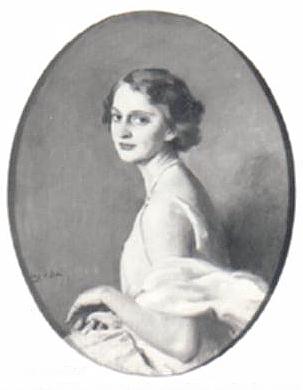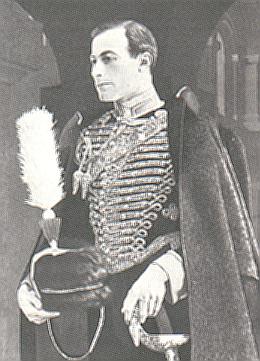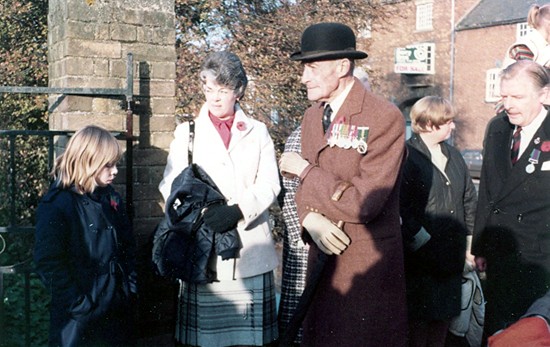|
 |
The Earl
of
Ancaster
1907-1983 |
The third and last Earl of Ancaster is remembered as a man whose life was devoted to public service, both at national and local level. He lived at the ancestral home, Grimsthorpe Castle, but maintained close links with Bourne and many organisations were grateful for his patronage because he became their president or vice-president and kept a high profile in the town's affairs, frequently attending functions and meetings and always giving unstinting support.
Gilbert James Heathcote-Drummond-Willoughby was born on 8th December 1907, son of the second Earl of Ancaster and his wife Eloise, second daughter of W L Breese of New York, USA. He was educated at Eton and Magdalene College, Cambridge, where he graduated with an MA degree. While at Cambridge, he had a keen interest in sport and was included in the squash racquets trials from which the Varsity team was selected. Horsemanship also fascinated him. Lord Ancaster had been a regular follower to hounds and in 1930 he rode a winner at Lingfield racecourse, returning 135 to one on the tote although he confessed afterwards that he had never backed it. It was also his ambition to ride in the Grand National and although he never achieved this, he did own and train steeplechase horses himself and rode regularly at point-to-point meetings and in 1947, he became chairman of the Cottesmore Hunt committee.
|
 |
 |
|
Gilbert James, 3rd
Earl of Ancaster, 26th Baron,
and his wife, the Hon Phyllis Astor. |
In 1933, he married the Hon Nancy Phyllis Louise Astor, the only daughter of the second Viscount Astor and his wife Nancy who later became Britain's first woman MP
to sit in the House of Commons. In the same year, he was elected Conservative MP for Rutland and Stamford and served the constituency until 1950. During his Parliamentary career, he accepted the invitation of Mr H A Marquand, the Minister of Pensions, in 1948 to serve on the Central Advisory Committee and he also became vice-president of the Poultry Association of Great Britain.
After entering politics, he had to give up a great deal of his sporting activities but still managed to indulge his fondness for cricket and turned out whenever he could for Swinstead Cricket Club and often assisted at the Edenham and Grimsthorpe, a club that has now closed. During his time in the House of Commons, he maintained a close interest in local sport by donating trophies for competition to various organisations in the Bourne area.
In 1937, he was appointed a Justice of the Peace, sitting regularly on the bench at the magistrates' court in Bourne. When the Second World War broke out in 1939, he was commissioned in the Leicestershire Yeomanry, serving later with the Royal Artillery, reaching the rank of major and was wounded on active service, losing a foot in Normandy, and was mentioned in despatches.
Returning to civilian life, he resumed his life on politics but after losing his seat at the 1950 election, turned to local government and was elected a member of Kesteven County Council that same year and was appointment alderman in 1954. When his father died in 1951, he succeeded to the earldom and took his seat in the House of Lords as the 26th Baron Willoughby de Eresby (created 1313) and he was also the fourth Baron Aveland (created 1856).
Lord Ancaster was Lord Great Chamberlain of England from 1950-52 and was appointed by the Queen as Deputy Lord Lieutenant of Lincolnshire in 1948, succeeding Lord Brownlow as Lieutenant two years later. His father, the earl, was then Lord Lieutenant of Rutland and thus father and son were in the unique position of occupying the office at the same time. He served
as Lord Lieutenant of Lincolnshire continually for the next 25 years and in 1971 was made a Knight Commander of the Royal Victorian Order.
In 1948, he accepted the presidency of the Kesteven Association of Parish Councils on its formation. He was also elected president of the English Speaking Union, the Lincolnshire Boy Scouts' Association and in 1950, the Lincolnshire Local History Society. He was initiated into the Stamford Cecil Lodge of the RAOB in 1934, the Swinstead Lodge of the Oddfellows (Manchester Union) in 1936 and was also an honorary member of the Stamford Albion Lodge. Among the many organisations in Bourne that were honoured to have Lord Ancaster as their president were the Royal British Legion, the Civic Society and the Bourne Town Cricket Club and he was also an honorary member of the Bourne Rotary Club and patron of the Baston Horse and Pony Society.
In 1978, the earl established a charitable trust to run his family affairs, transferring the estates at Grimsthorpe, Edenham and Drummond Castle near Crieff in Perthshire, Scotland, under its jurisdiction, together with a large part of the family's collection of art and antiques. The object of the arrangement was to preserve the houses and contents for the public benefit, the advancement of education and for other charitable purposes.
|
 |
|
The Earl of Ancaster pictured
taking the salute at the Remembrance Day parade in Bourne on Sunday 14th November 1982. The uniformed officer with him
on the dais is Squadron Leader Paul Moules of the RAF and standing at the rear
is Councillor Don Fisher of the Bourne branch of the Royal British Legion.
|
|
 |
|
The earl arriving for the annual Remembrance Day service at the War
Memorial gardens in Bourne on Sunday 8th November 1981.
|
The earl's many interests in public life ranged over a diverse number of activities and at one time, he was either president or vice-president of 100 organisations. Because of his war injury, he worked untiringly to better the lot of disabled ex-servicemen through his active support of the British Limbless Ex-Service Association and the Royal British Legion, becoming patron of the Lincolnshire association in 1951 and he was also closely associated with the Winged Fellowship Trust.
Lady Ancaster died tragically on Sunday 2nd March 1975, aged 65. She was
found unconscious by her maid, Miss Vera Stenton, in her room at Grimsthorpe Castle
early that morning and died later in Stamford Hospital. An inquest held at
the hospital the following Tuesday was told that she found her lying on
the floor at right angles to the bed and a screen had been knocked over.
"It looked as though the countess had been sitting on the bed and had
slipped to the floor, knocking over the screen", said Miss Stenton. "I
called for assistance and got her back into bed. She was alive but
unconscious and very cold." Dr F J Fawcett, consultant pathologist, said
that the countess had been suffering from bronchial pneumonia which was a
secondary cause of death. "The fall was of sufficient force that she was
almost certainly concussed from the time she fell", he said. "The main
cause of death was her fall in which she sustained a head injury which
caused a blood clot over the surface of the brain and this was sufficient
to kill her. I do no think it would have made the slightest difference if
she had been found any earlier because of the nature of the injury." The
coroner, Mr A R Kelham, recorded a verdict of accidental death.
The earl died at Grimsthorpe on 29th March 1983 at the age of 75 and the earldom that had been created in 1892 died with him
together with the barony of Aveland while the baronetcy, also held by him, was passed on to a
distant relative, Gilbert Simon Heathcote. The ancient Barony of
Willoughby de Eresby, however, was inherited by his only daughter, Nancy. The funeral was held privately at Edenham village church and afterwards there were memorial services at Lincoln, Muthill (near Crieff), and London.
The couple had one son who had been heir to the family titles, Timothy Gilbert, Lord Willoughby de Eresby (born 19th March 1936),
but he lost his life in a tragic boating accident off Cap Ferrat in 1963.
|
BRITAIN'S
FIRST WOMAN M P
|
|
Lady Ancaster's
mother was Nancy Witcher Langhorne who was born in May 1879 at Danville, Virginia, USA, daughter of Chiswell Dabney
Langhorne, a wealthy tobacco auctioneer. She married Robert Gould
Shaw in 1897 and after obtaining a decree of divorce in 1903,
married Waldorf Astor, the second Viscount Astor, in 1906. |
 |
|
She eventually succeeded him as the Conservative MP for the Plymouth Sutton division in 1919, so becoming the first woman MP to sit in the House of Commons where she served until 1945, known for her interest in social problems, especially women's rights and temperance. Viscount Astor died in 1952 and the Viscountess spent her final
years at Grimsthorpe Castle where she died in on 2nd May 1964,
aged 84. |
REVISED NOVEMBER 2011
See also
Lady Jane
Willoughby The
first Earl of Ancaster
The Heathcote family
The Willoughby Memorial Library Lord Willoughby's
Private Railway
A History of Grimsthorpe Castle The
Grimsthorpe fires
The General Election of 1910
Viscount Midleton

Go to:
Main Index Villages
Index
|





